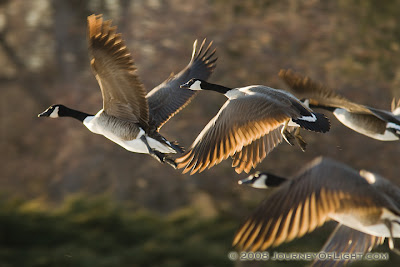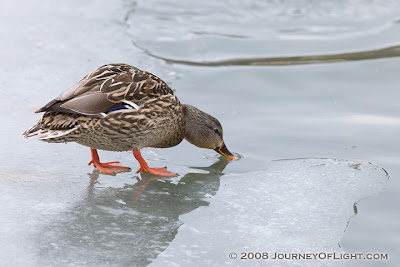 To the Sky
To the SkyTechnical Details:
Canon 5d Mark II, 300 f/4l+1.4 tc, f/5.6, 1/1000 sec., ISO 400

Coming in for a Landing
Technical Details:
Canon 5d Mark II, 300 f/4l + 1.4 tc, f/5.6, 1/500 sec., ISO 200
First up I am addressing the autofocus system. There has been a lot of discussion on the web about the fact that the autofocus system is the same from the 3 year old Canon 5d (Mark I) and that an upgrade should have been necessary. Over the years, I have found the autofocus in the Canon 5d acceptable, but not exemplary. For the majority of my landscape, this is a non-issue since I focus manually most of the time. For large critters such as bears and deer, this becomes more of an issue, but I have found the autofocus hits more than it doesn't. Birds, however, are a different story. I found that the autofocus was lacking slightly more of the time. Most birding and wildilfe photographers would use AI Servo, however, on the Canon 5d I found AI Servo slower than one-shot, although I am sure that this is more a photographer technique issue than a technical issue. As such, I have stuck with one-shot mode, of which was used to capture all of these photographs. The Canon 5d Mark II, like its predecessor sports 6 helper autofocus points for AI Servo which may have helped my cause. I do plan on getting more experience with AI Servo on the Canon 5d Mark II in the future, however.
The second subject I have really noticed the average autofocus speed is on my 18 month old daughter. I have found that the autofocus is just not fast enough to capture her most of the time, although I think even the 1d Mark III (no AI Servo here!) or Nikons 3-d autofocus system would have trouble with that moving subject. Regardless, my experience is that the speed of autofocus with the accuracy is about the same as the Canon 5d, no real improvement there. It would have been nice, but for me, not a deal killer.
The last note I would like to make regarding the autofocus system is the addition of microadjustment of autofocus on a per lens basis. For years photographers have complained about lenses front focusing or back focusing on each new model of camera. Essentially, since both the lens and the camera are machined parts there is an allowance for a variance of some specifications while still considered being "calibrated". For the most part, this variance is not detected, but for photographers who require precise focus (and shouldn't we all?) this could cause photos with some lens+camera combinations to be slightly out of focus. The Canon 5d Mark II now addresses this by allowing each lens to be calibrated by the user to the camera. This now allows all those lens+camera combinations that front focus or back focus to focus precisely. I welcome this addition as I have found that my Canon 20d front-focused slightly with my 300 f/4l lens. At first, I thought the lens was fuzzy, or it was a lack of megapixels, but after it focused perfectly on my Canon 5d (and other lens focused find on my 20d) I realized I too was subccumbing to the "front/backfocusing" hell that others had complained/blogged/reviewed/previewed/etc. about.

A Flight with Friends
Technical Details:
Canon 5d Mark II, 300 f/4l + 1.4 tc, f/5.6, 1/320 sec., ISO 400
The next feature (and the most important one in the marketing department) is the increase in megapixels. The Canon 5d Mark II packs 21 megapixels into a full-frame sensor. This allows for better detail and tighter cropping of the composition. I know when I used to use my Canon 20d with 8 megapixels, I would be hesitant to crop some of my compositions, but now even a liberal crop retains great detail, granted that you are using a high-quality lens. I am quite pleased with the new number of megapixels. The resolution and detail is definitely there and I feel like it is a great upgrade from 12.8 megapixels from the previous generation. A lot of people comment that the megapixel race should end as there are all sorts of adverse effects that start manifesting themselves (such as noise) at higher pixel densities. If 21 was the upper limit on a full-frame sensor, I think I could definitely live with that.

A Quick Stop
Technical Details:
Canon 5d Mark II, 300 f/4l + 1.4 tc, f/6.3, 1/320 sec., ISO 640
The third item I am going to address is ISO performance. There has been quite a bit of discussion on the net surrounding the noise levels at higher settings. Since this is more of a real-world look than a technical review (there are lots of sites dedicated to that), I am going to simply discuss what I have seen. The ISO levels seem better than the Canon 5d by somewhere from about 1 to a little less than 2 stops. This means that greater detail and less noise is available at higher ISOs. On my Canon 5d I never had any problem dialing the ISO up to about 800 for some shots. 1600 was about my absolute maximum for retaining detail. Beyond that I found that I had to use noise programs fairly liberally. All the wildlife photographs on this blog post were shot using a minimum of ISO 400 up to 640. This allowed me to achieve shutter speeds that would stop the action, but allow a little blur to show the movement of the birds. At these speeds there is virtually no noise.
Quiet Day
Technical Details:
Canon 5d Mark II, 50 CM, f/5.6, 1/50 sec., ISO 6400
To follow up with a little more testing in a (little) more controlled environment, I decided to purposely photograph my stationary cats at ISO 6400. I found the noise was well-controlled and definitely an welcome improvement. Another nice feature is that the ISOs are set at third (or half depending on your preferences) stops up to 6400. That means that I have good selection of ISO speeds between 1600 and 6400 to use without changing a full stop. On the Canon 5d, after 1600 the only choice was a full stop up to 3200. Beyond 6400 on the Canon 5d Mark II, the noise makes the image degrade to a point where I would find it unusable for a print, unless I was applying liberal use of filters and noise control. Even then I question it's real-world application for my primary work. In a pinch, though it is useful to capture the shot in conditions that I would have been unable to get it before, although it may just frustrate me in post-processing.
Reflection on Libby
Technical Details:
Canon 5d Mark II, 50 CM, f/2.5, 1/60 sec., ISO 6400
Overall, I find the Canon 5d Mark II to be a worthy successor to the Canon 5d. It doesn't have everything I wanted (I would like DEP mode back, but that's just me I think), but it has enough to warrant an upgrade. There are always function and features to be added and on future posts I may comment on a few of those. Check back to see what new feature I might dig up.
One last note, I processed all these photographs from RAW using Adobe Photoshop CS3 and the free DNG converter found here. Adobe conveniently ended RAW support for CS3 right before the Canon 5d Mark II was released (and well after it was announced). Some couldn't even get a copy of CS4 prior to receiving their camera! While I agree with drawing a line in the sand for support, most companies, including ones like Microsoft offer support for the current version and one previous. I find that ending support as a way of forcing upgrade when the product (CS4) isn't even released a bit much. For those who cannot afford the upgrade there are several support sites dedicated to the DNG converter (such as scripting and processing) and I recommend that you look into those.
1 comments:
Who knows where to download XRumer 5.0 Palladium?
Help, please. All recommend this program to effectively advertise on the Internet, this is the best program!
Post a Comment